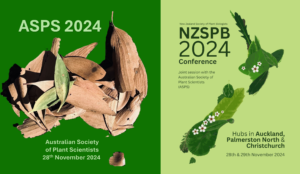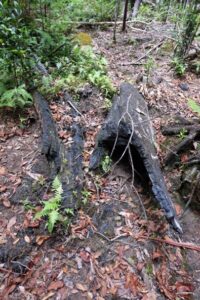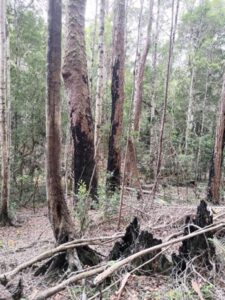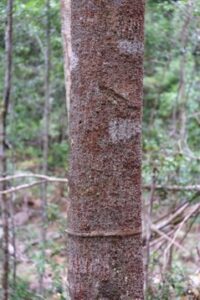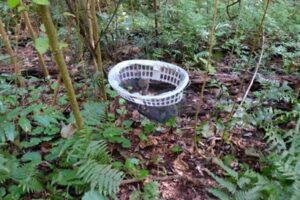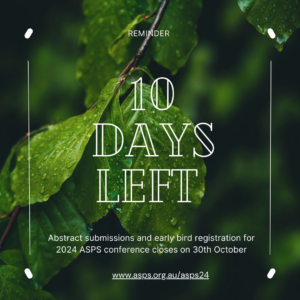- About
- Members
- Join
- Member log in
- Membership Renewal
- Member directory
- Life Members
- ASPS Life Member Professor Graham Farquhar
- ASPS Life Member Associate Professor Hendrik (Hank) Greenway
- ASPS Life Member Dr Marshall (Hal) D Hatch
- ASPS Life Member Dr Paul E Kriedmann
- ASPS Life Member Dr Mervyn Ludlow
- ASPS Life Member Emeritus Professor Rana Munns
- ASPS Life Member Conjoint Professor Christina E Offler
- ASPS Life Member Professor (Charles) Barry Osmond
- ASPS Life Member Emeritus Professor John W Patrick
- ASPS Life Member Dr Joe Wiskich
- Corresponding Members
- Elected Fellows
- Events
- Awards & Funding
- Employment
- Publications
- Research
- Teaching
- Menu
December 2024 Phytogen
16 December 2024
Welcome to the last edition of Phytogen for 2024!
For this final edition of the year, we take a look back at the local conference and the annual general meeting of the Society held at the end of last month. We welcome some new faces to the Society who will commence their roles in 2025. We also continue to spotlight our student members. This month we feature Yalin Liu, a first-year PhD student affiliated with the School of Biosciences at The University of Melbourne.
We welcome contributions from students and researcher at any time for publication in Phytogen. Its free and a great way to give your research profile a boost and share your findings! Send your contribution to our editors Raz (razlin.azman@csiro.au) or Lucas (L.Auroux@latrobe.edu.au).
2024 ASPS Local Conferences
The ASPS 2024 conference was a hybrid conference held concurrently across Australia and New Zealand at the end of last month. This event brought together plant scientists across Australia, with strong participation from NSW and ACT (117 attendees), QLD (64), SA (66), VIC (55), and WA (55). Colleagues from other states/territories joined online, making it a truly national gathering of ideas and research. It featured local meetings connected virtually for the ASPS and NZSPB award presentation session, where each award winner presented. This event brought together plant scientists to share research, collaborate, and strengthen connections within and across states and territories.
The ASPS would like to sincerely thank the local organising committees for making these events possible with the generous supports of our sponsors:
- National sponsors: Bioplatforms Australia, the ARC Centre of Excellence for Plant Success in Nature and Agriculture, and ThermoFisher Scientific.
- Award and lecture sponsors: Functional Plant Biology, The Annals of Botany Company, and Agrisera Antibodies.
- Local sponsors: the Australian Plant Phenomics Network (VIC, WA, NSW); the Australian Genome Research Facility (WA); Qiagen (WA), John Morris Group (WA), Licor Inc, the Western Sydney University School of Science and Hawkesbury Institute for the Environment (NSW); ARC Centre of Excellence for Plant Success in Nature and Agriculture and the Queensland University of Technology (QLD); Flinders University, The University of Adelaide, ARC Centre of Excellence for Plants for Space, Waite Research Institute and the South Australian Genomics Centre (SA).
Here are some winners for best talks and posters. Congratulations to all winners and thank you to all presenters for sharing your research at the conference. Your participation continues to make our annual conferences a success and a platform for plant scientists in Australia to share their research and form professional networks.
NSW & ACT
Best Student Presentation
University of British Columbia (visiting the Australian National University)
Academic profile | The University of British Columbia interview | X: @Nicole Bison
Student Presentation Runner-up
Australian National University
Best Student Poster
 Edward Chaplin
Edward Chaplin
University of Sydney
The University of Sydney interview
Student Poster Runner Up
Haoran Li
Australian National University
VICTORIA
Best ECR Presentation
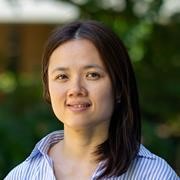 Lim Chee Liew
Lim Chee Liew
LaTrobe University
Lim Chee Liew Profile | La Trobe University
X: @LimCheeLiew
Best Student Presentation
Olivi Doolanm LaTrobe University
Olivia Doolan | La Trobe University Profile
Best Poster
 Thomas Cobbinah, La Trobe University
Thomas Cobbinah, La Trobe University
WESTERN AUSTRALIA
Best Presentation
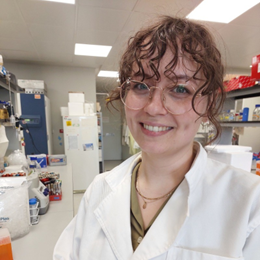 Samantha Norman
Samantha Norman
University of Western Australia
Best Poster
University of Western Australia
X: @andy_tuckey
ASPS 2024 annual general meeting
The Society’s Annual General Meeting was held on 29 November 2024. On behalf of the Society we would like to thank Professor Martha Ludwig whose term as President will end on 1 January 2025. Martha’s work strengthened the links between each state and profoundly enhanced the exhibition of plant science in Australia, thank you Marta. The President-Elect, Professor Brent Kaiser, will become the new President of the Society on 1 January 2025. Welcome Brent! Martha will continue to stay on the Society exec.
(L): Martha Ludwig ; (R): Brent Kaiser
Voting at the Annual General Meeting resulted in the election of new volunteers to fill the vacant positions from 2025:
Honorary secretary
Associate Professor Mary Byrne
University of Sydney
Academic profile | Lab Webpage
Associate Professor Mary Byrne is a plant geneticist studying plant development. Her group has made contributions to our understanding of genetic pathways that distinguish stem cell from differentiated cell fate in the plant shoot meristem, and to our understanding of genes and genetic pathways that determine leaf shape. She is a passionate teacher of undergraduate and graduate students studying plant science and genetics.
Discipline representatives
Welcome new discipline reps, and many thanks to outgoing discipline reps for their contribution to ASPS and Phytogen during the year.
Student representatives
Welcome to our new student representatives, representing VIC, QLD, WA and SA. We thank Zane Marks (U of Adelaide) for his effort and contribution to ASPS and Phytogen in 2024.
Student Contribution

Yalin Liu
PhD student, School of Biosciences, The University of Melbourne
yalliu1@student.unimelb.edu.au
Yalin Liu is a first-year PhD student in Mike Haydon’s Lab at the University of Melbourne, bringing a wealth of experience in molecular biology, biochemistry, and plant science.
Her research journey began during her master’s studies in the Constabel’s Lab at the University of Victoria, Canada, where she employed CRISPR knock-out techniques to study the transcriptional regulation of tannins in poplar trees. “This project deepened my understanding of gene regulation mechanisms in plants and provided me with extensive hands-on experience in wet lab” Yalin reflects. Her work was summarized in a peer-reviewed publication: Yalin Liu, Dawei Ma, C. Peter Constabel. CRISPR/Cas9 disruption of MYB134 and MYB115 in transgenic poplar leads to differential reduction of proanthocyanidin synthesis in roots and leaves. Plant and Cell Physiology, 2023, DOI:10.1093/pcp/pcad086. Following her MSc, Yalin further expanded her skill set by learning epigenetic techniques as a research assistant in Hong Kong.
Currently, Yalin’s PhD research focuses on unravelling the molecular mechanisms that control the circadian clock in wheat. Her work seeks to understand how plants integrate environmental signals to regulate developmental processes like leaf senescence, a crucial factor in crop productivity. “My passion lies in exploring how transcriptional regulation controls the circadian system to optimize plant growth and stress responses,” she explains. Her research promises to provide new insights into the role of the circadian clock in wheat, offering practical applications in crop improvement and sustainability.
Acknowledgements: Yalin Liu’s work is funded by the University of Melbourne and GRDC.
Editors’ note
We hope you had a great time at this year’s ASPS 2024 conference. Phytogen will be back at the end of January 2025. Until then, enjoy the time off!
Invited contribution: student contribution by Yalin Liu
Newsletter written and edited by Lucas Auroux and Razlin Azman.
AGM coming up
29 November 2024
Hello ASPS members,
The AGM is due to start soon. Log into the meeting HERE. https://latrobe.zoom.us/j/86306555958
Meeting starts:
VIC, NSW, ACT 1 pm
SA 12.30 pm
QLD 12 noon
WA 10 am
AGM documents can be accessed HERE.
ASPS 2024, Phytogen, AGM and Annals of Botany Travelling Lectureship.
27 November 2024
Hello ASPS members,
We’re looking forward to catching up at the ASPS 2024 Hub meetings on Thursday 28th November. The ASPS 2024 website can be accessed HERE. Contact your Hub leader directly if you have questions on the day.
The November edition of Phytogen can be accessed HERE.
Join us for our AGM on Friday 29th November at 1 pm DST. View the AGM documents HERE. Join the AGM virtual meeting HERE.
Congratulations to Dr Caitlin Moore who has been awarded the inaugural Annals of Botany Travelling Lectureship. 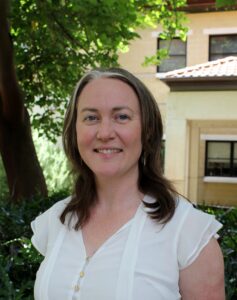
Caitlin is a Senior Lecturer in the School of Agriculture and Environment at The University of Western Australia. She is a representative for Australia’s Terrestrial Ecosystem Research Network (TERN) in Western Australia, and is the communications officer for the OzFlux network. Caitlin received her PhD from Monash University on a project looking at carbon fluxes and phenology dynamics in Australian tropical savannas. She then completed a four-year postdoc at the University of Illinois Urbana-Champaign in the USA applying her skills to phenotyping and understanding climate and management impacts in agricultural cropping systems. Back in Australia, her current research broadly focuses on understanding native and managed ecosystem interactions with climate from the leaf to landscape scale.
November 2024 Phytogen
19 November 2024
Welcome to the November 2024 edition of Phytogen!
Our annual ASPS conference, incorporating the NZSPB conference is just around the corner! Registrations are still open for the conference and dinner. You can join in the conversation on the day on X using #asps2024. The ASPS Annual General Meeting will be held online on 29th November 2024.
This issue we highlight the other ASPS winners who will be presenting at the conference – Peter Crisp (Peter Goldacre Award), Ashley Jones & Benjamin Schwessinger (Outreach and Education winners), and Sergey Shabala (JG Wood Lecture). We also have a contribution from Dr. Kristine Crous, our Environmental & Ecophysiology Representative, and student contribution from Arka Dutta, PhD student at La Trobe University.
Expression of Interest are still open to be part of ASPS as council members and discipline reps.
We welcome contributions from students and researcher at any time for publication in Phytogen. Its free and a great way to give your research profile a boost and share your findings! Send your contribution to our editors Razlin (razlin.azman@csiro.au) or Lucas (L.Auroux@latrobe.edu.au).
2024 ASPS Award Winner Spotlight: Peter Goldacre Award
School of Agriculture and Food Sustainability, Faculty of Science, University of Queensland & Centre for Crop Science, Queensland Alliance for Agriculture and Food Innovation
Academic profile: UQ Profile
Lab webpage: Crsip lab
Social media (X): @Pete_crisp
Google Scholar: Peter Crisp
Dr Peter Crisp is a Group Leader and Senior Lecturer in the School of Agriculture and Food Sustainability at The University of Queensland. Peter’s research program is focused on crop functional genomics, epigenetics and biotechnology, and has significantly advanced our understanding of the contribution of epigenetics to heritable phenotypic variation in plants. His group has invented groundbreaking technologies for harnessing (epi)genetic variation and their discoveries have led to exciting new avenues for decoding genomes and for the rational engineering of gene regulation for trait improvement in plants. Having benefited immensely from brilliant mentors, Peter is passionate about training. He leads a budding group of talented students and researchers and is a Chief Investigator in the ARC Training Centre in Predictive Breeding and the International Research Training Group for Accelerating Crop Genetic Gain. Peter is also an affiliate of the Queensland Alliance for Agriculture and Food Innovation and the ARC Centre of Excellence for Plant Success in Nature and Agriculture.
Peter completed his PhD in functional genomics and intracellular signalling at the Australian National University under the supervision of Prof Barry Pogson; then from 2017 was a Postdoctoral Fellow at the University of Minnesota, USA under the mentorship of Prof Nathan Springer working on epigenomics in maize. Peter joined UQ in 2020 as a Group Leader and Lecturer Crop Biotechnology and genomics in the School of Agriculture and Food Science in the Plant Science cluster. At UQ Peter also held an ARC DECRA Fellowship followed by a UQ Amplify Fellowship.
2024 ASPS Award Winner Spotlight: Education and Outreach Award
Dr Ashley Jones
Research School of Biology, Australian National University
Academic profile: ANU Profile
Social media (X): @dnawhisperer
Ashley is a research scientist at the Australian National University, specialising in genomics and molecular biology. Key research areas are genome structure, transcriptomics, long non-coding RNAs, nucleic acid sequencing, SARS-CoV-2, bioinformatics and evolutionary biology.
Research School of Biology & ARC Training Centre for Future Crops Development
Australian National University
Academic profile: ANU Profile
Lab webpage: Schwessinger Lab page
Google Scholar: Benjamin Schwessinger
Benjamin has been working on plants and fungi in various aspects from signalling to genomics and from biochemistry to bioinformatics. He started off with Arabidopsis before moving to rice and Xanthomonas. His current work is focused on fungi called rusts with a focal point on the wheat stripe rust fungus Puccinia striiforims f. sp. tritici. Benjamin is fascinated by biology in general and by observing living systems in interaction.
Over the past seven years, Ashley and Benjamin have continuously innovated their teaching of the latest genomic analysis approaches in plant sciences, spearheading the establishment of Oxford Nanopore sequencing across Australia and in the class room. Their impact in plant science teaching and beyond has been significant, influencing multiple sectors including universities, industries, government, and communities. Key to these achievements, is that they pursue a highly integrative approach to teaching from wet lab protocol development to dry lab analysis pipeline sharing. In addition, we focus on development of wider scientific communities, as we share teaching materials and protocols online via Protocols.io.
2024 ASPS Award Winner Spotlight: JG Wood Lecture
School of Biological Sciences, University of Western Australia
Academic profile: UWA Profile
Google Scholar: Sergey Shabala
Sergey is the Chair in Plant Physiology at the University of Western Australia. He is also a Distinguished Professor and a Director of the International Research Centre for Environmental Membrane Biology at Foshan University in China. His area of expertise is stress physiology and membrane transport in plants. His work is aimed at revealing and quantifying the role of specific ion transporters in plant adaptive responses to salinity, waterlogging, osmotic stress, chilling, acidity, elicitors and oxidative stress, as well as to understand the signalling cascades mediating plant-environment interactions. Professor Shabala revolutionised the once mysterious field of plant stress biology by introducing and applying ‘MIFE’, a trademarked non-invasive tool for studying the adaptive responses of plant cells and tissues to a large number of stresses.
Be part of ASPS!
Nominations are now accepted for the following positions in ASPS. You can nominate using this form ASPS-Council-Nomination-Form-5, and send to Janet Wheeler (Janet.Wheeler@latrobe.edu.au). The positions will remain open until filled.
- ASPS secretary
- Education and Outreach
- Diversity and Inclusion
- Student representative
Discipline leads:
- Cell Biology Representative
- Plant-Microbe Interactions Representative
Environmental & Ecophysiology Representative
Institute for Molecular Bioscience, Hawkesbury Institute for the Environment
Western Sydney University
Academic profile: Western Sydney Uni profile
Lab webpage: Crous Lab
Google Scholar: Kristine Crous
The 2019-2020 bushfire season was one of the worst in history with about 24 million hectares burnt across the country. This bushfire season was preceded by a strong drought lasting for several years and resulting in crisp, dry leaves underfoot in the forest, even in rainforests. We now call this season the “Tinderbox drought” as the long drought prepared many landscapes for easy ignition, including in rainforests.
Rainforests usually don’t burn due to high moisture levels, but large parts of world heritage-listed Gondwanan rainforests did in 2019-2020. This event opened up a unique opportunity for researchers to investigate how resilient rainforests are to bushfire. After the initial resprouting and reseeding phase, there was cautious optimism that rainforest were moving on and recovering. However, these rainforests did not evolve with fire and have thin bark.
My team at Western Sydney University set up a contrast of control (no burn) and burned plots in Northern NSW three years after the fires to investigate the longer-term effects of bushfire on rainforest species. These plots are rich and diverse in species, including both the foundation species as well as some threatened species. Many of these rainforest species have ancient Gondwanan lineages, going back 40-50 million years to the time when Australia broke off from Antarctica. Rainforest species responses to fire include resprouting, re-seeding, and mortality, with overall slower recovery rates compared to other ecological communities (e.g. eucalypt-dominated forests).
Even five years after the fire, there is a vast contrast between burned and control plots. Charcoal on the stems reveal the scars of the burn (Fig. 1) and the open canopy of the burned plots makes you feel exposed to the sun, unusual in normally closed-canopy rainforests. Some trees have no leaves at all, exposed cracks in their bark or show signs of fungal attack on their stems (Fig. 2). These are signs of a slow death. Trees are still dying years after the burn with stem fall regularly occurring.
Fig 1 (L: Charcoal traces on fallen trunk in the aftermath of fires; R: Fire scars left behind. Photo credits: Amy Smart)
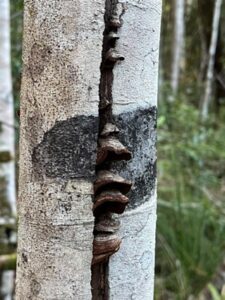 Fig 2: Fungal attack after fire (photo credit: David Ellsworth).
Fig 2: Fungal attack after fire (photo credit: David Ellsworth).
The capacity to recover ecosystem productivity and reinstate nutrient cycling is important to the overall long-term resilience of rainforests. Our team is monitoring aboveground productivity in burned and control plots. This involves stem growth via dendrometer bands (Fig. 3), leaf canopy increment via canopy photos and leaf litter fall (Fig. 4) as a turnover component. Nutrient dynamics are also contrasted in burned and control plots including nutrient resorption and soil nutrients to investigate how nutrients influence rainforest recovery after fire. Plant traits such as bark thickness, vulnerability to embolism and heat tolerance are also measured. While initial green resprouting may have been seen as ‘recovery’, bushfires may push rainforests to an alternative vegetation type and eliminate habitat for threatened and endangered species. It is clear that this ecosystem still has a long trajectory towards restoring what was here before with ongoing impacts even five years after fire.
This project is still ongoing and funded by the Hermon Slade Foundation. We are hoping to gain insights into recovery trajectory of rainforests after fire on two different soil types. A deeper understanding of post-fire responses and aboveground productivity is crucial to assess the long-term resilience and recovery of rainforest species and improve biodiversity conservation strategies after fire.
(L)Fig 3 Dendrometer band on tree, photo credit: Amy Smart; (R) Fig 4: Leaf litter trap in the woods, photo credit: Amy Smart
Student Contribution
Arka Dutta
PhD candidate, La Trobe Institute for Sustainable Agriculture and Food (LISAF – AgriBio research centre)
Department of Animal, Plant and Soil Sciences, School of Agriculture, Biomedicine and Environment, La Trobe University
Academic profile: Arka Dutta profile | La Trobe University
Motivated by an intrinsic curiosity, Arka Dutta’s research path has led him internationally to La Trobe University, where he is currently a 2nd year PhD student. “As a child, I was enormously influenced by Madam Curie and Rosalind Franklin’s biographies, and wanted to pursue a career in fundamental science. Growing up, I spent a considerable time with my father, a mathematics professor who inadvertently drew me into the field ofscience. Tackling one problem through multiple approaches and arriving at a conclusion with robust scientific reasoning was what I liked the most about doing science.
Throughout my entire academic career, I had the opportunity to carry out internships in different laboratories and I realized that performing experiments, troubleshooting them, and asking logical questions in a meaningful way is a passion more than anything”.
“My key scientific interest lies in understanding the intricate networks in plants that regulate nutrient uptake, utilization, and reallocation, with the goal of engineering crops to enhance their nutritional immunity and resilience against diverse stress conditions”
Arka’s PhD research question focuses on understanding the adaptive strategies plant use to modulate the cellular phosphate sensors (SPXs) proteins, to regulate the homeostasis of phosphate and nitrate signalling in plants.
During his PhD, Arka had the opportunity to be a co-author in some of the most renowned peer-reviewed plant Journals. Here is a budding list of publication from Arka, that highlights his research contributions:
Balancing act: The dynamic relationship between nutrient availability and plant defence
The Plant Journal (2024)
DOI: https://doi.org/10.1111/tpj.17098
The fnr-like mutants confer isoxaben tolerance by initiating mitochondrial retrograde signalling
Plant Biotechnology Journal12 pages Wiley-Blackwell
DOI: 10.1111/pbi.14421
Phosphate starvation regulates cellulose synthesis to modify root growth
Plant Physiology194(2):1204-1217 (14 pages) Oxford University Press
Editors’ note
Phytogen will be back for our next issue for the 2024 ASPS conference wrap up
We look forward to see you all in person and online for the conference.
Phytogen, job board, register for ASPS2024
21 October 2024
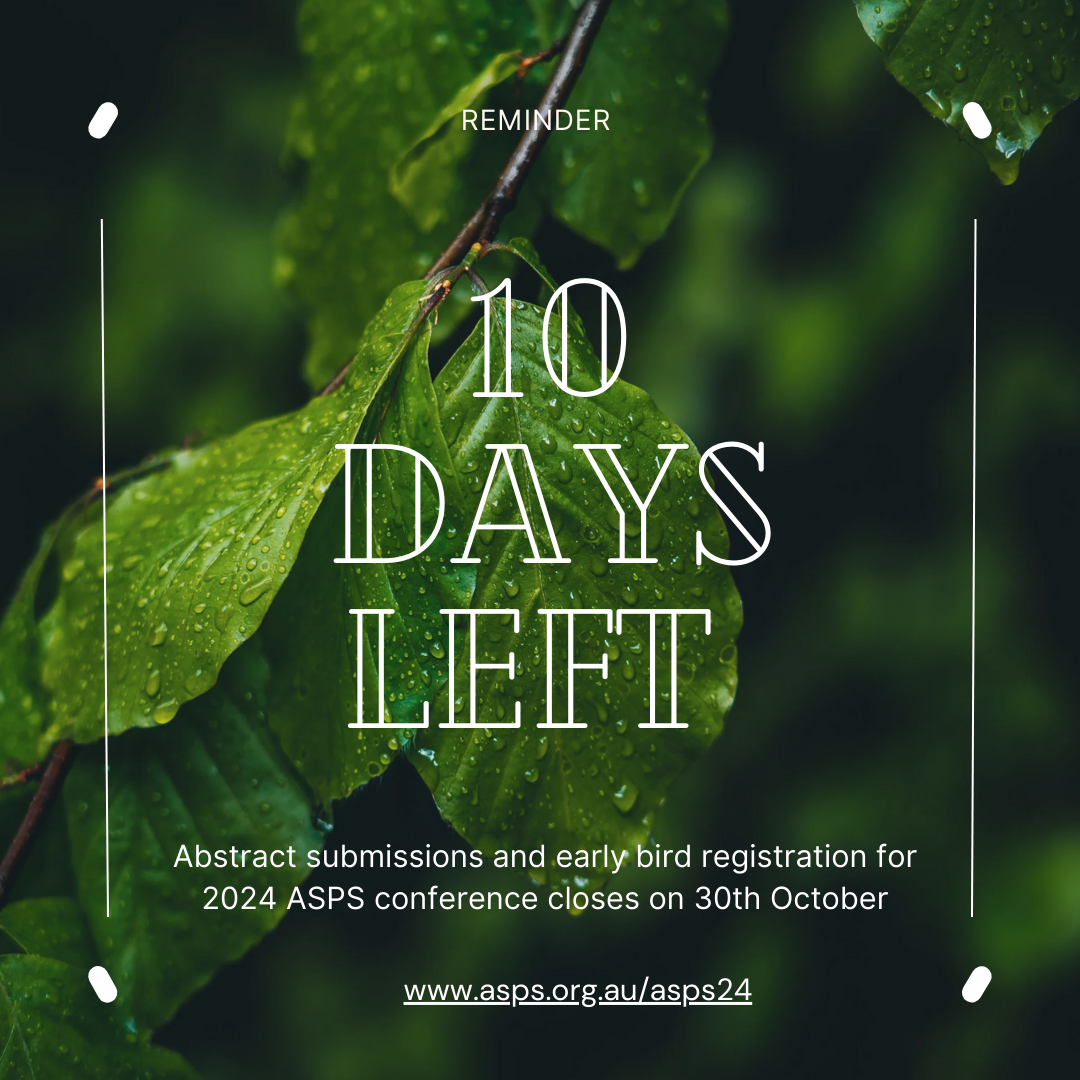
Hello ASPS members,
The October edition of Phytogen is out and can be accessed HERE.
Latest STA newsletter can be accessed HERE.
ASPS job board has new jobs and scholarships posted and can be accessed HERE. New Scholarship HERE. New job HERE.
ASPS 2024 registration and abstract submissions are still open. Details HERE.
Interested in getting more involved in ASPS? Nominate for one of the position below. Nomination form is attached.
- ASPS secretary
- Education and Outreach
- Diversity and Inclusion
- Student representative
Discipline leads:
- Cell Biology
-
Plant-microbe interactions
October 2024 Phytogen
20 October 2024
Welcome to the October 2024 edition of Phytogen!
Early registration and abstract submissions for the ASPS conference closes on 30th October. Register and submit an abstract for your local ASPS hybrid conference HERE
This issue we highlight A/Prof Jenny Mortimer, recipient of the 2024 Jan Anderson Award. We also have a contribution from Dr. Nipuni Peththa Thanthrige, our Genetics & Molecular Biology Representative, student contribution from Ben Wee, a final year PhD student in ARC Medicinal Agriculture Hub at La Trobe University, and we round up with the final cohort of student awardees of the travel grant of the International Plant and Molecular Biology (IPMB) conference held in Cairns in June.
Expression of Interest are still open to be part of ASPS as council members and discipline reps.
We welcome contributions from students and researcher at any time for publication in Phytogen. Its free and a great way to give your research profile a boost and share your findings! Send your contribution to our editors Razlin (razlin.azman@csiro.au) or Lucas (L.Auroux@latrobe.edu.au).
2024 ASPS Award Winner Spotlight: Jan Anderson Award
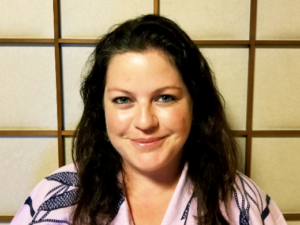 A/Prof Jenny Mortimer
A/Prof Jenny Mortimer
University of Adelaide
Academic profile : UoA profile
Lab webpage: mortimerlab.org/.
Social media (Twitter) Jenny_Mortimer1
Google Scholar Jenny Mortimer – Google Scholar
The editorial team congratulates Jenny Mortimer on her Jan Anderson Award. Jenny is an Associate Professor of Plant Synthetic Biology in the School of Agriculture, Food and Wine at the University of Adelaide (UoA), Australia, where she is also Deputy Director (Interim) of the Waite Research Institute. She is Chief Investigator (CI) and UoA node leader of the ARC Centre of Excellence Plants for Space (P4S). She is also an Affiliate Staff Scientist at Lawrence Berkeley National Laboratory, USA, and a Director of Plant Systems Biology at the Joint BioEnergy Institute, USA. After completing her PhD at Cambridge University, UK, she began exploring how engineering the plant cell wall could deliver sustainable and economically viable biofuels: first as a postdoc in Cambridge, then as a research fellow at RIKEN Japan, before joining Berkeley Lab in 2014, and Adelaide in 2021. Her team’s research focuses on understanding and manipulating plant cell metabolism, with a focus on complex glycosylation. The goal is to develop knowledge and crops which contribute to a sustainable and renewable bioeconomy.
At Adelaide, her group is using synthetic biology to develop new crops for food and materials production in controlled growth environments – including for Space settlement (P4S), applying new agricultural biotechnologies to develop resilient field crops as a CI in the ARC Training Centre for Future Crops Development, and developing Australian feedstocks for sustainable jet fuel as a CI in the ARC Research Hub for Engineering Plants to Replace Fossil Carbon. She collaborates extensively internationally, and projects include a UK Space Agency funded project to develop a plant growth facility for Axiom Station, and a NASA funded project to develop a payload for Artemis III, the mission that will return humans to the surface of the moon. She was selected as a World Economic Forum Young Scientist (2016/17), where she contributed to the WEF Code of Ethics for Researchers (widgets.weforum.org/coe), and she is an editor for the society journals Plant Cell Physiology and Plant Journal.
Editors’ note: Jan Anderson award is in honour of Joan (Jan) Mary Anderson FAA FRS FDhc (Umeå), an internationally acclaimed plant biologist renowned for her discoveries on the organization of the intricate membrane structures that carry out solar energy conversion in cells of green plants. Jan’s experiments and insights changed the way we think about the light reactions of photosynthesis. Her research career spanned some 55 years, mostly at the Division of Plant Industry CSIRO Canberra (1961-97) and then in the Research School of Biological Sciences at the Australian National University. Jan was a passionate and creative female scientist who was well ahead of her time. She was an inspiration to young researchers, for whom her enthusiasm and curiosity were infectious. Professor Jan Anderson died on 28 August 2015 after a short illness. In recognition of her life and achievements in photosynthesis research as a pioneering female scientist, this award will acknowledge talented female plant science researchers.
Be part of ASPS!
Nominations are now accepted for the following positions in ASPS. You can nominate using this form ASPS-Council-Nomination-Form-5, and send to Janet Wheeler (Janet.Wheeler@latrobe.edu.au). The positions will remain open until filled.
- ASPS secretary
- Education and Outreach
- Diversity and Inclusion
- Student representative
Discipline leads:
- Cell Biology Representative
- Plant-Microbe Interactions Representative
Genetics and Molecular Biology Representative
 Dr Nipuni Peththa Thanthrige
Dr Nipuni Peththa Thanthrige
Institute for Molecular Bioscience, The University of Queensland, Brisbane (Queensland)
Academic profile: UQ profile| The ARC Centre of Excellence for Innovations in Peptide and Protein Science (CIPPS)
Nipuni is a postdoctoral research fellow at the Institute for Molecular Bioscience, The University of Queensland, and is also affiliated with the ARC Centre of Excellence for Innovations in Peptide and Protein Science. Her research interests include plant molecular farming, abiotic stress tolerance, programmed cell death, and plant-microbe symbiosis. Currently, she works in Professor David Craik’s lab, where she uses Nicotiana benthamiana and cowpea as platforms for producing antimalarial peptides in plants, aiming to develop plant-based treatments for malaria. The Craik group achieved a significant breakthrough fifteen years ago with the discovery of cyclotides—ultra-stable peptides with a unique structure resistant to digestive breakdown. This discovery has opened the door to the development of a new generation of targeted, potent drugs and agrichemicals. Nipuni’s work applies this innovation to the production of antimalarial peptides in plants, pushing the boundaries of plant-based therapeutic production.
Before joining Craik’s group, Nipuni worked at the Queensland Alliance for Agriculture and Food Innovation (QAAFI) on a GRDC-funded sorghum project aimed at improving grain quality. Her experience in both fundamental and applied research has shaped her multifaceted approach to plant science.
Nipuni joined UQ in 2022 after completing her PhD at Queensland University of Technology (QUT). Her doctoral research focused on understanding the molecular mechanisms of co-chaperone Arabidopsis thaliana Bcl-2-associated athanogene 4 (BAG4)-mediated stress tolerance. Her findings have been published in high-impact journals such as Trends in Plant Science, Frontiers in Plant Science, and Scientific Reports, with another paper currently under review in PNAS. In 2022, she won the People’s Choice Award at the Falling Walls Brisbane Pitching Competition and was a finalist in the national competition.
Editor’s note: you can access Dr Nipuni Peththa Thanthrige Falling Walls Brisbane pitching competition where she received the people’s choice award HERE.
Additionally, Nipuni received the New Phytologist Next Generation Scientists travel grant in 2023, allowing her to present her research at the New Phytologist Next Generation Scientists Symposium in Singapore.
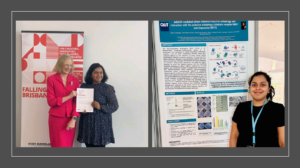 Image (L to R): Nipuni receiving the People’s choice award at Falling Walls (Brisbane 2022); Nipuni presenting her research at the New Phytologist Next Generation Scientists Symposium (Singapore (2023)
Image (L to R): Nipuni receiving the People’s choice award at Falling Walls (Brisbane 2022); Nipuni presenting her research at the New Phytologist Next Generation Scientists Symposium (Singapore (2023)
Beyond her research, Nipuni is passionate about teaching and mentoring the next generation of scientists. She is currently co-supervising two PhD students and has delivered some plant biology lectures in plant biology courses at QUT. During her PhD, she served as the lead tutor for three biology course units. Her dedication to education is reflected in outstanding student feedback, and her enthusiasm for mentoring is evident through her continued efforts to share knowledge and expertise. Her academic journey was recently featured in Careers with STEM magazine. Nipuni was a member of the ASPS organizing committee in 2023 and is now chairing the upcoming ASPS QLD Node Conference in November 2024. As the Genetics and Molecular Biology Representative for ASPS, she is excited to promote plant molecular biology and biotechnology research both in Australia and globally, believing that ASPS provides an excellent platform for advancing this mission.
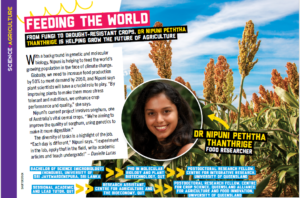
Image: Careers with STEM magazine
Student Contribution
 Benjamin Wee Yang
Benjamin Wee Yang
PhD candidate, ARC Industrial Transformation Research Hub for Medicinal Agriculture, La Trobe Institute for Sustainable Agriculture & Food (LISAF – AgriBio research center), Department of Animal, Plant and Soil Sciences, School of Agriculture, Biomedicine and Environment, La Trobe University
Benjamin Wee Yang Profile | La Trobe University | Linkedin
With extensive experience in the horticultural industry, Benjamin is now in the final year of his PhD at La Trobe University. “My professional background in horticulture has shaped my focus on delivering practical research outcomes for the growers, particularly for high-value crops like medicinal plants. There’s a significant opportunity to influence cultivation practices towards more sustainable targets, given the relative infancy of the industry” he explains.
“Following my time in industry, I found the ideal opportunity with the ARC Medicinal Agriculture Hub, based at AgriBio, La Trobe University—a leading centre for agricultural biosciences. And after these three years, I can honestly say it’s been one of the best decisions I’ve made. The Hub brings together a wealth of expertise, and the leadership has been incredibly supportive in helping us achieve our research goals. Being part of the Phenotyping and Cultivation team has also added an invaluable interdisciplinary dimension to my work, under the excellent guidance of Dr Oliver Berkowitz and Dr Ricarda Jost, respectively.”
Benjamin’s PhD research focuses on nutrient use in hemp and drug type Cannabis sativa. “By integrating physiological, metabolomic and transcriptomic data from a carefully controlled study system, my objective is to identify key markers for efficient nutrient use in this multi-purpose crop,” he says. His research aims to provide actionable insights that will promote more sustainable agricultural practices and enhance crop performance in commercial production systems. Read his latest peer reviewed article on the subject HERE
Acknowledgements: The work was funded by the ARC ITRH for Medicinal Agriculture (IH180100006) and involved the industry partners Photon Systems Instruments and Cann Group.
Student travel grant awardees report – IBMP Cairns 2024
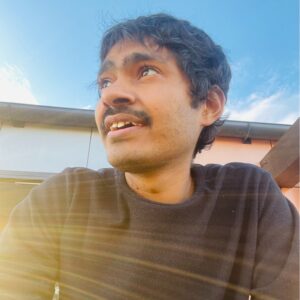 Happy Singh – UWS (NSW)
Happy Singh – UWS (NSW)
LinkedIn: Happy Singh
I, Happy, PhD candidate at Hawkesbury Institute of the Environment of Western Sydney University (Australia) thrilled to share my wonderful experience at the International Plant Molecular Biology Conference (2024) held in Cairns this year. First and foremost, I would like to extend my gratitude to the IPMB committee for giving me the opportunity to present a portion of my research and for selecting me for the Travel Grant Award. It was an incredible experience to learn about the groundbreaking work being conducted by renowned researchers and scientists in their respective fields. I presented a poster on my PhD work titled “Cellular Vibration by Sound Waves Disrupts Poricidal Cone Trichomes to Boost Tomato Pollination, Seed Set, and Fruit Size.” I had the opportunity to interact with numerous researchers and scientists, engaging in discussions to understand the significance of sound waves in agriculture. Additionally, I received valuable suggestions to improve the quality of my research. Overall, presenting my poster at IPMB was a great experience, and I learned a lot about how the scientific community operates. The plenary sessions were particularly outstanding, both at the beginning and the end of the conference, showcasing the meticulous effort put in by the organizing committee. It was also a fantastic opportunity to connect with students and researchers from all over the world, sharing diverse scientific perspectives and areas of interest. Overall, it was an incredible experience to be part of such a remarkable conference.
Zuba Ahmed – QUT (QLD)
LinkedIn: Zuba Ahmed
 Attending the IPMB 2024 conference in Cairns was a wonderful experience. I was able to build my network and learn about the exciting advances in plant science from around the world. It was my first time presenting my research at an international conference, and I am thankful for ASPS for providing travel funding to attend. The conference program was diverse with many opportunities to connect with other PhD students and researchers. I especially enjoyed the plenary speaker sessions held throughout the conference and the invited speakers were a great source of motivation for my own work and career development.
Attending the IPMB 2024 conference in Cairns was a wonderful experience. I was able to build my network and learn about the exciting advances in plant science from around the world. It was my first time presenting my research at an international conference, and I am thankful for ASPS for providing travel funding to attend. The conference program was diverse with many opportunities to connect with other PhD students and researchers. I especially enjoyed the plenary speaker sessions held throughout the conference and the invited speakers were a great source of motivation for my own work and career development.
Editor’s note: Zuba worked with an indigenous artist to create a Nicotiana benthamiana t-shirt based on her research
Khaksefidi Reyhaneh – Uoa (SA)
Bio: Researcher Profile – The University of Adelaide | LinkedIn: Khaksefidi Reyhaneh
Receiving the IPMB travel award from the Australian Society of Plant Scientists was a significant honour, and I thoroughly enjoyed the conference both scientifically and socially. This award enabled me to attend the 13th International Congress on Plant Molecular Biology held in Cairns. Attending this conference in Australia was a highlight of my PhD journey as I had the opportunity to network with researchers from around the world. The sessions were incredibly informative, offering insights into the latest research and developments in plant science. I had the chance to present my poster titled ‘Exploring MicroRNA-Mediated Regulation in Barley Inflorescence Development,’ which received valuable feedback from peers and experts in the field. Attending sessions expanded my knowledge and inspired new ideas for my future research. Overall, the conference was a remarkable experience, and I am grateful to ASPS for making it possible.
Editors’ note
Phytogen will be back for our next issue in mid-November, JUST before the 2024 conference happens. Don’t forget to register!
Stay spooky, green thumbs
September Phytogen
30 September 2024
Welcome to the September 2024 edition of Phytogen!
Welcome Spring! As we are approaching the warmer months, our ASPS conference is getting closer (To register and submit an abstract for your local ASPS hybrid conference HERE).
This issue we congratulate the 2024 ASPS winners and publication by our members. We have a contribution from Pr. Lucas Cernusak, our Education Representative, and a research contribution from Dr. Francine Perrine-Walker. Also included in this issue is 2023 R.N Robertson Travelling Fellowship report. We also continue to highlight our student awardees of the travel grant of the International Plant and Molecular Biology (IPMB) conference held in Cairns in June.
There are several opportunities to be part of ASPS.
We welcome contributions from students and researcher at any time for publication in Phytogen. Its free and a great way to give your research profile a boost and share your findings! Send your contribution to our editors Razlin (razlin.azman@csiro.au) or Lucas (L.Auroux@latrobe.edu.au).
Celebrating achievements
Congratulations to the winners of the 2024 ASPS award who will be presenting at the ASPS hybrid conference happening in late November.
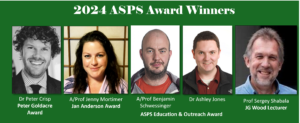
Peter Goldacre Award: Dr Peter Crisp (UQ profile | X: pete_crisp)
Jan Anderson Award: Assoc Prof Jenny Mortimer (UoA profile | X: Jenny_Mortimer1 )
ASPS Education and Outreach Award: Dr Ashley Jones (ANU profile |X: dnawhisperer ) & Assoc Prof Benjamin Schwessinger (ANU profile | X: @schwessinger | Research Group)
JG Wood Lecturer: Prof Sergey Shabala (UWA profile)
In addition, congratulations to ASPS member Dr Lim Chee Liew and colleagues (LaTrobe Uni) for their publication in Nature Plants and the front cover feature.
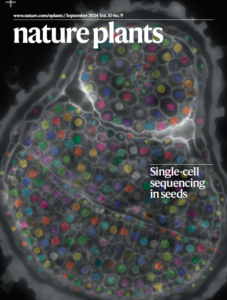
Image by Lucas Auroux and Lim Chee Lim
Be part of ASPS!
Nominations are now accepted for the following positions in ASPS. Please reach out to Janet Wheeler (Janet.Wheeler@latrobe.edu.au) if you are interested in getting involved in these roles.
- ASPS secretary
- Education and Outreach
- Diversity and Inclusion
- Student representative
Discipline leads:
- Cell Biology Representative
- Plant-Microbe Interactions Representative
Education Representative Update
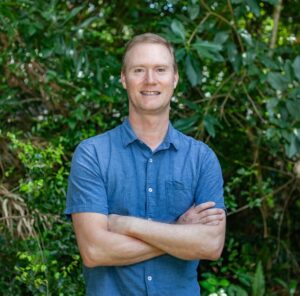 Pr. Lucas Cernusak, College of Science and Engineering, James Cook University, Cairns Campus (Queensland)
Pr. Lucas Cernusak, College of Science and Engineering, James Cook University, Cairns Campus (Queensland)
Bio: Pr. Lucas Cernusak | James Cook University
Lucas Cernusak is a Professor of Plant Science at James Cook University, Cairns. His main research interest is to understand the environmental and biological controls on carbon dioxide and water vapour exchange between leaves and the atmosphere. He is also interested in improving the interpretation of stable isotope signals in plant organic material, to better understand how leaf gas exchange has responded to global climate change through time and how it varies across ecological gradients. He and his lab group at James Cook University are especially interested in understanding these processes in tropical trees and responses of tropical rainforests to climate change and rising atmospheric CO2.
Lucas joined James Cook university in 2013 as an ARC Future Fellow, after having completed his PhD in the Research School of Biology at the Australian National University, after which he did postdoctoral research at the Smithsonian Tropical Research Institute in the Republic of Panama and Charles Darwin University in Darwin, Northern Territory. He has been a member of the ASPS since beginning his PhD in 2000. Over his career, Lucas has published more than 150 peer-reviewed journal articles and book chapters.
In addition to his research, Lucas is also passionate about plant science education, outreach, and engagement. Lucas has made substantial contributions to the academic community through mentorship and teaching. He has supervised numerous PhD students to completion, helping his students win research grants and publish their research under his guidance. His dedication to teaching is reflected in exemplary student feedback scores, and he continually strives to make a lasting impact in the classroom.
Looking ahead, Lucas is excited to have been elected to the role of Plant Science Education Representative in the ASPS, and to have the opportunity to promote plant science education in Australia and internationally. He strongly believes that the ASPS provides an ideal vehicle for doing this.
R.N Travel Fellowship Report
Exploring Genome Structure in Cicer echinospermum through Oligo-FISH Chromosome Barcoding

Report by: Alistair Hockey
PhD candidate
The UWA School of Agriculture and Environment, University of Western Australia
In a world of increasing digitalisation, it’s easy to lose touch with the physical components that make up our world. An ongoing reliance on bioinformatic analysis in the fields of genetics and genomics has led to the inference of genetic factors and effects with little to no independent physical evidence. Such is the case with the study of genome structure diversity, a field founded in cytogenetics, now dominated by genome sequence analysis and inference. Genome structure is a key determinant of gene flow dynamics within and between species, with differences in structure often resulting in barriers to gene flow. With the support of the R.N. Robertson Travelling Fellowship, I set out to identify, validate and characterise genome structure diversity in chickpea (Cicer arietinum ssp. arietinum L.) and Cicer echinospermum P.H. Davis through, oligo-FISH chromosome barcoding, a modern cytogenetic approach.

Image: Dolní náměstí, Olomouc city centre
My PhD project is focused on uncovering post-zygotic barriers to gene flow in Cicer echinospermum to better understand the species coherence and relationship to closely related sympatric species. Cicer echinospermum is the only known annual Cicer species (2n = 2x = 16) capable of hybridizing with chickpea to produce semi-fertile hybrids. Moreover, the genetic diversity within C. echinospermum far exceeds that of domesticated chickpea (108 times greater!) (von Wettberg et al., 2018). Introducing novel genetic material to increase genome-wide diversity in chickpea could be beneficial for both short-term and long-term crop improvement. However, barriers to gene flow between the two species exist, large genome structure variation chief among them. Karyotypic variation between the two species was first discovered by Ladizinsky and Adler (1976), who observed meiotic chromosome pairing aberrations in F1 hybrids and concluded the two species differed by a reciprocal translocation. Since then, most identification and characterization of large genome structural variations (> 1 Mbp) between the two species have been through bioinformatic analyses (e.g., pangenomes).
In my PhD project, I am using both bioinformatic and cytogenetic approaches to identify, validate, and characterize genome structure variation within C. echinospermum. Olomouc, a Czech university city in the heart of Moravia, is known for its baroque-style architecture and is home to the Institute of Experimental Botany (UEB). The Hribova Lab at UEB developed an oligo-FISH barcoding system for chickpea. This modern cytogenetic approach allows for the physical characterization of karyotypic diversity in chickpea. Thanks to a collaboration between my primary supervisor Dr. Judith Lichtenzveig and Prof. Jaroslav Dolezel, I had the opportunity to spend June 2024 working with the Hribova Lab in Olomouc to test the chickpea barcoding system on C. echinospermum. Additionally, I attended the EMBO Plant Genome Stability and Change 2024 workshop in Olomouc and presented a seminar on my current PhD findings.
We planned two experiments to produce mitotic chromosome spreads from meristematic root tips and label chromosomes through oligo-FISH barcoding. One experiment involved cell cycle synchronization to prepare mitotic chromosomes at metaphase I, while the other used a simpler protocol to halt cell cycle continuation in meristematic root tips. Both experiments then followed the same protocols to prepare protoplast suspensions and perform fluorescent in situ hybridization. We started with one chickpea variety and one C. echinospermum accession to confirm the reciprocal translocation identified almost 50 years ago. Initially, everything went smoothly, and we clearly identified the reciprocal translocation between the two species based on the oligo-FISH barcodes on chromosomes. We also confirmed that the cell cycle synchronization protocol was more effective for detecting mitotic chromosomes at metaphase I and the protocol worked better for chickpea, the species it was designed.
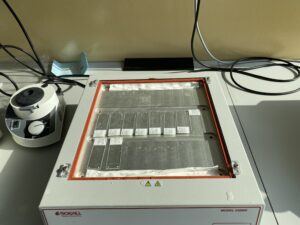
Image: Probe hybridisation on mitotic spread slides
Subsequent iterations of these experiments faced challenges due to equipment malfunctions and seed germination issues. Additionally, some protocols optimized for chickpea were not optimal for C. echinospermum, which limited probe visualization for several C. echinospermum accessions. In response, we prepared for future experiments at the University of Western Australia, where I can use the expertise I gained to optimise the protoplast suspension protocol and perform oligo-FISH barcoding to investigate genome structure diversity within C.echinospermum.
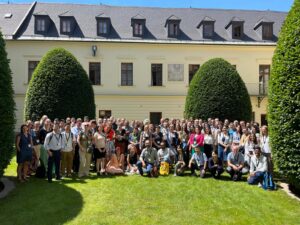
Image: Plant Genome Stability and Change, 2024
My time at the EMBO workshop was invaluable. Presenting my research sparked discussions with peers and leaders in my field. The exposure to innovative and intriguing research helped me develop ideas for future projects and opened my eyes to the opportunities available. It was fantastic to just spend four days discussing all of the new research in great company. All in all, a month spent in the European summer is never wasted. After long days in the lab, I often walked the perimeter of the old city, following the parklands that once formed a moat around the medieval fortifications ‒ a daily blend of the modern and the ancient. I can’t imagine a better place to have further developed my abilities in plant cytogenetics. The welcoming nature of everyone at UEB immediately made me feel at home, especially after a sunny afternoon roasting špekáček sausages over an open fire on the institute grounds, paired with Czech pilsner.
I am particularly grateful to Jana Cizkova and Eva Hribova, whose attentiveness, interest, and openness provided me with an unparalleled learning opportunity. Their introductions to research leaders from other labs at UEB sparked discussions that gave me novel insights and ideas for future research. I’d also like to thank my supervisor Judith Lichtenzveig, whose inspiration for the research trip, involvement in approach development, and ongoing supervision of this research project cannot be understated. Lastly, I thank the ASPS for awarding me the R.N. Robertson Travelling Fellowship, which allowed this research trip to take place, and the University of Western Australia’s Graduate Research School for additional funding.
Research Spotlight
Bacterial Biosensors: The cumate-inducible sfGFP expression system to study Rhizobium leguminosarum bv viciae – vetch interaction
Written by: Francine Perrine-Walker (PhD), The University of Sydney (LinkedIn | Google Scholar | X: PerrineWalker)
There have been some advances in the use biosensors in rhizobia to monitor oxygen and proline in Pisum sativum nodules [1,2], root exudates in the pea and vetch rhizosphere [3] and glutamine in the alfalfa, lentil, pea and soybean roots and nodules [4]. So, imagine if you could have a microscopic tool in your lab such as a Rhizobium bacterial cell sensing any compound released by a legume or a non-legume plant and monitor how such cells reacted in the rhizosphere or within roots.
In molecular biology, inducible gene expression systems (or vectors) have been useful tools for biotechnological applications. In such systems, an inducer, when present allosterically, binds to and renders inactive a transcriptional regulator/repressor which is bound to the operator sites in the promoter region of target genes [5]. Inducers can be anything such as glycerol [6], anthranilate [7], or even green light [8]. Kaczmarczyk and colleagues [5] demonstrated the advantages of inducible gene expression systems from Pseudomonas putida [9, 10] that could be induced in the presence of p-cumate and synthetic vanillate in sphingomonads and Alphaproteobacteria. Interestingly, Assoc. Prof. N. Coleman and M. Sommerville (University of Sydney) had a Rhizobium strain, R. leguminosarum bv. viciae 3841, in their collection expressing the cumate-inducible expression system i.e., the plasmid pUS248-sfGFP (superfolder green fluorescence protein).
To test this if the cumate-inducible expression system in R. leguminosarum bv. viciae 3841 could be used to monitor infection and nodulation of legumes in the presence of p-cumate, Namoi woolly pod vetch was used in two different growth conditions: a) the mounted glass-slide growth system previously described in Fahräeus [11] and modified in Perrine-Walker et al. [12] and, b) the standard nodulation assays [11, 13]. As inoculants, the wild-type R. leguminosarum bv. viciae 3841 (WT) and the transformant, R. leguminosarum bv. viciae 3841 expressing the pUS248-sfGFP were grown on YMA [14] and YMA agar plates supplemented with kanamycin at 25 µg/mL (Km 25) to maintain the pUS248-sfGFP in transformants and p-cumate at 50 mM to activate GFP expression at 30oC respectively. Plant materials (intact roots and/or sectioned, squashed nodules) were examined using fluorescence microscopy.
Preliminary results were encouraging. For the mounted glass-slide growth system, in the presence of p-cumate, GFP-expressing R. leguminosarum bv. viciae 3841 pUS248-sfGFP transformants adhered/attached to the surface of a root hair post 90 min inoculation (Fig. 1 c). At 24, 48 and 72 h, the fluorescent bacteria were found trapped in curled root hairs and within infected cortical cell regions below infected root hairs (Fig. 1 d-j) compared to control uninoculated vetch seedlings (Fig. 1 b). A GFP signal was observed in sectioned roots i.e., within infection threads traversing cortical cell region (Fig. 1 h-j).
For nodulation assays, no nodules were observed on the roots of uninoculated plants, whereas nodules were observed in WT strain inoculated plants post 21 and 30 d (Table 1). Furthermore, no or diffuse GFP signal was detected within infected cells of sectioned nodules of inoculated p-cumate treated R. leguminosarum bv. viciae 3841 pUS248-sfGFP-inoculated plants (Fig. 1 k-m). In NFN-medium, with and without p-cumate, no nodules were observed on control plants. Plants inoculated with WT strain formed nodules (Table 1) however in the presence of p-cumate, no GFP signal was observed in squashed nodules or in root sections under the microscope after 21 and 30 d post inoculation. In plants inoculated with R. leguminosarum bv. viciae 3841 pUS248-sfGFP in the absence of p-cumate, nodulation occurred (Tables 1) but no GFP signal was observed in nodules and on the surface of root sections after 21 and 30 d post inoculation. In the presence of p-cumate, GFP signals were observed on the surface of root sections, in infection threads found within curled root hairs that extended towards putative nodule primordia (Fig 1. n) post 21d inoculation and zone II section of vetch nodules on seedlings inoculated with R. leguminosarum bv. viciae 3841 pUS248-sfGFP post 30 d inoculation (Fig 1. p-o).
In conclusion, the cumate-inducible gene expression system did not affect root hair attachment and curling, infection thread infection and nodulation of the Rhizobium leguminosarum bv. viciae strain 3841 with the plasmid pUS248-sfGFP (superfolder green fluorescence protein) in the presence of p-cumate (summarized in Figure 2). The inducible expression vector with the superfolder GFP could be useful, but more work would be needed to determine if the construct could be modified to be inducible by another compound other than p-cumate.
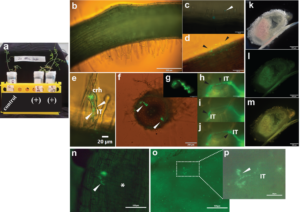
Fig. 1 Visualization of Rhizobium leguminosarum bv. viciae 3841 pUS248-sfGFP in vetch roots using the mounted glass slide method and nodulation assays; (a) Growth of individual vetch plants uninoculated (control) and inoculated with R. leguminosarum bv. viciae 3841 pUS248-sfGFP using the mounted glass slide method in the presence of Kanamycin at 25 µg/mL and p-cumate at 50 mM (+); (b) uninoculated vetch root (control); (c) GFP- labelled bacteria on the surface of an individual root hair post 90 min inoculation (white arrowhead); (d) root hair deformation (black arrowheads) and sfGFP-expressing rhizobia on the plant root surface; (e) sfGFP-labelled bacteria within two putative developing infection threads in a curled root hair (white arrow); (f) two infection sites within the cortical cell region of a sectioned vetch root (white arrowheads); (g) close-up of one the infection sites shown in (f); (h-j) close up of the infection site in (f) showing sfGFP-labelled rhizobia within the infection thread traversing three cortical cells; (k-m) hand-sectioned nitrogen-fixing nodule on a vetch root inoculated R. leguminosarum bv. viciae 3841 pUS248-sfGFP; (k) under bright field; (l) same nodule in (k) under the U-MGFPHQ filter specific for GFP; (m) same nodule in (k) under U-MWIB2 filter showing diffuse GFP fluorescence signals; (m)infection threads containing GFP-labelled rhizobia growing towards a putative nodule primordium (white asterisk); (n) infection thread junction with two sfGFP-labelled bacteria within a zone II nodule region; (o) squashed zone II region of a vetch nodule displaying infection threads with and without GFP signals and; (p) close up of an infection thread section in (o; white dashed rectangle) containing sfGFP-labelled rhizobia. Note – Images in (h-j) are the same region at three different focal planes to highlight the infection thread (IT). Fluorescence images (b), (c), (d), (e) and (f) were captured using U-MWIB2 filter with bright field light (h-j) and (m) with the same filter with no bright field light. Images in (g) and (l) were captured under the U-MGFPHQ filter specific for GFP only. (b) to (m) were captured using the Olympus BX51 microscope and seedlings were grown on Jensens plant media supplemented with p-cumate. (n) to (p) were captured using the Nikon Ti2 microscope and seedlings were grown on NFM supplemented with p-cumate. crh, curled root hair; IT, infection thread.
Table 1. Nodulation of Namoi woolly pod vetch by R. leguminosarum bv. viciae strain 3841 and R. leguminosarum bv. viciae 3841 pUS248-sfGFP post 21 d on Jensen’s and NFM plant growth medium without kanamycin. Each experiment had a total of 6 and 12 plants for each treatment respectively. The number of plants that nodulated were recorded post 21 or 30 d.
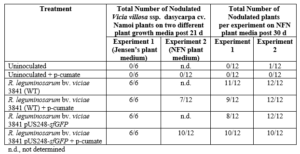
![]()
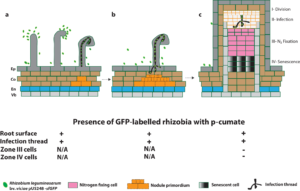
Fig. 2 Schematic diagram summarizing the expression of sfGFP in rhizobia in vetch in the presence of p-cumate in plant growth media. In the presence of p-cumate in plant growth media, GFP signal were observed on surface of vetch roots as well as to the tips of root hairs and curled root hairs and within infection threads (a). (b) sfGFP-labelled rhizobia were also in infection threads growing towards nodule primordia and (c) infection threads with the zone II of vetch nodules. No GFP signal were found in zone III and zone IV of vetch nodules.
Acknowledgments
I would like to thank Dr J. Hartley for kindly donating the vetch seeds and M. Sommerville for the Rhizobium strains and helpful advice as well as Profs. B. Kaiser and D. Guest for access to laboratory materials and fluorescent microscopes. I would also like to thank Assoc. Prof. N. Coleman for use of the Rhizobium strain expressing the plasmid pUS248-sfGFP. Plasmid pUS248-sfGFP (a gift from Nicholas Coleman’s lab, University of Sydney) was made by joining the replication and resistance regions of pBBR1MCS-2 [15] to the p-cumate regulatory system components derived from Pseudomonas putida [5] and the superfolder GFP gene (sfGFP) [16].
References
- Rutten PJ, Steel H, Hood GA, Ramachandran VK, McMurtry L, Geddes B, Papachristodoulou A, Poole PS (2021) Multiple sensors provide spatiotemporal oxygen regulation of gene expression in a Rhizobium-legume symbiosis. PLOS Genetics 17 :e1009099. doi:10.1371/journal.pgen.1009099
- Rubia MI, Ramachandran VK, Arrese-Igor C, Larrainzar E, Poole PS (2020) A novel biosensor to monitor proline in pea root exudates and nodules under osmotic stress and recovery. Plant Soil 452 :413-422
- Pini F, East AK, Appia-Ayme C, Tomek J, Karunakaran R, Mendoza-Suarez M, Edwards A, Terpolilli JJ, Roworth J, Downie JA, Poolea PS (2017) Bacterial biosensors for in vivo spatiotemporal mapping of root secretion. Plant Physiol 174 :1289-1306
- Thilakarathna MS, Raizada MN (2018) Visualizing glutamine accumulation in root systems involved in the legume–rhizobia symbiosis by placement on agar embedded with companion biosensor cells. Phytobiomes Journal 2 :117-128
- Kaczmarczyk A, Vorholt JA, Francez-Charlot A (2013) Cumate-inducible gene expression system for sphingomonads and other alphaproteobacteria. Appl Environ Microb 79 :6795-6802
- Doi Y (2015) L-lactate production from biodiesel-derived crude glycerol by metabolically engineered Enterococcus faecalis: Cytotoxic evaluation of biodiesel waste and development of a glycerol-inducible gene expression system. Appl Environ Microb 81 :2082-2089
- Hoffmann L, Sugue MF, Bruser T (2021) A tunable anthranilate-inducible gene expression system for Pseudomonas Appl Microbiol Biot 105:247-258
- Abe K, Miyake K, Nakamura M, Kojima K, Ferri S, Ikebukuro K, Sode K (2014) Engineering of a green-light inducible gene expression system in Synechocystis PCC6803. Microb Biotechnol 7:177-183
- Eaton RW (1996) p-Cumate catabolic pathway in Pseudomonas putida F1: Cloning and characterization of DNA carrying the cmt operon. J Bacteriol 178 :1351-1362
- Eaton RW (1997) p-Cymene catabolic pathway in Pseudomonas putida F1: Cloning and characterization of DNA encoding conversion of p-cymene to p-cumate. J Bacteriol 179 :3171-3180
- Fahräeus G (1957) The infection of clover root hairs by nodule bacteria studied by a simple glass slide technique. J Gen Microbiol 16 :374-381
- Perrine-Walker FM, Kouchi H, Ridge RW (2014) Endoplasmic reticulum-targeted GFP reveals ER remodeling in Mesorhizobium-treated Lotus japonicus root hairs during root hair curling and infection thread formation. Protoplasma 251 :817-826
- Jensen HL (1942) Nitrogen fixation in leguminous plants. II. Is symbiotic nitrogen fixation influenced by Azotobacter? Proc Linn Soc NSW 67: 205-212
- Allen EK, Allen ON (1950) Biochemical and symbiotic properties of the rhizobia. Bacteriol Rev 14 :273-330
- Kovach ME, Elzer PH, Hill DS, Robertson GT, Farris MA, Roop RM, 2nd, Peterson KM (1995) Four new derivatives of the broad-host-range cloning vector pBBR1MCS, carrying different antibiotic-resistance cassettes. Gene 166 :175-176
- Pédelacq JD, Cabantous S, Tran T, Terwilliger TC, Waldo GS (2006) Engineering and characterization of a superfolder green fluorescent protein. Nat Biotechnol 24 :79-88
Student travel grant awardees report – IBMP Cairns 2024
 Samuel James Nix – ANU (ACT)
Samuel James Nix – ANU (ACT)
Samuel Nix | ANU Research School of Biology
Overall, the conference was a fantastic experience. There were multiple plenary talks that I enjoyed. Robert Furbank’s C4 Rice Project presentation was a good presentation on how difficult multi-gene transgenic projects can be approached. It was also interesting to see how biotechnology has advanced in the past 15 years and how that impacted the feasibility of the project. Another talk I enjoyed was Mohammad Ishiyaku’s presentation on GM Cow Pea, a great success story about how a GM crop can be embraced by a developing country and the local communities and be adapted to meet the commercial desires of the public. A fun plenary talk was Susana Coelho’s on sex evolution in brown algae. Additionally, I presented my poster Elucidating and Engineering Cell Specific Cyclic Electron Flow in C4 photosynthesis and I won an award! Lastly, and most importantly, I made new connections with fellow scientists during the conference.
 Sara Jalali – UoA (SA)
Sara Jalali – UoA (SA)
Sara Jalali | Researcher Profiles (adelaide.edu.au)
I, Sara Jalali, had the privilege of attending the International Plant Molecular Biology (IPMB) Conference in Cairns, Australia, from June 24th to June 28th, 2024. This conference was an invaluable experience, allowing me to engage with leading researchers in molecular biology, a field that directly relates to my PhD work. The event facilitated the exchange of innovative ideas and the discussion of potential collaborative research opportunities. Additionally, it helped me expand my professional network and stay informed about the latest advancements in plant molecular biology. I am deeply grateful to the ASPS for funding my travel, enabling me to participate in this enriching event.
 Rana Alqusumi – UWA (WA)
Rana Alqusumi – UWA (WA)
Profile: Rana Alqusumi (plantenergy.edu.au)
At the end of June 2024, I attended the IPMB 2024 Congress in Cairns, thanks to the ASPS travel award. The event prominently featured emerging researchers in plant molecular biology. It was an honour to listen to scientists from around the world discuss their latest advancements in plant science. One of the highlights was a presentation by Prof. Mitter from the University of Queensland, who shared her team’s research on using clay nanosheets for delivering RNAi as pesticides. This innovative application of nanotechnology in crop protection was particularly enlightening. Additionally, I had the pleasure of engaging with fellow plant researchers, exchanging insights about our respective fields of work. The congress provided ample opportunities for networking and collaboration. Beyond the academic experience, I also enjoyed exploring the city of Cairns. Overall, attending the IPMB 2024 Congress was an enriching experience offering valuable knowledge and memorable interactions.
 Saber Sohrabi – UoA (SA)
Saber Sohrabi – UoA (SA)
Saber Sohrabi | Researcher Profiles (adelaide.edu.au)
I, Saber Sohrabi, attended the International Plant Molecular Biology (IPMB) Conference, which took place from June 24th to June 28th, 2024, in Cairns, Australia. By participating in this conference, I had the chance to connect with researchers in my field of study, exchange ideas, and explore potential collaborations for future research projects. The conference focused on molecular biology, aligning perfectly with my PhD project. This experience allowed me to expand my professional network, stay updated on the latest developments, and establish myself as an active member of the academic community. I would like to thank the ASPS for funding my flights to attend this conference.
 Alicia Quinn – Monash (VIC)
Alicia Quinn – Monash (VIC)
LinkedIn | Twitter AliciaQuinnSci
Attending the IPMB 2024 conference in Cairns was a great opportunity to see the latest research in plant molecular biology and meet the people behind the work. The conference started strong with two excellent plenaries that set the tone for the rest of the week: Gerry Turpin on protecting Indigenous knowledge and Tetsuya Higashiyama on signalling during reproduction. The concurrent sessions were equally diverse – covering everything from evolution to cell signalling – and it was a challenge deciding what to attend. Presenting my work in the metabolic engineering session was a highlight, and the supportive audience made it a fantastic experience. I really enjoyed the evening poster sessions and it was great to chat about the exciting research currently underway. This conference was an invaluable experience and I’m grateful for the support from ASPS to attend. I look forward to the next one!
Editors’ note
Phytogen will be back for our next issue in late October Don’t forget, registration and abstract submission for the local ASPS meetings for each state/territory in Australia and New-Zealand are now open!
For those working outdoors, remember to stay protected, cool and hydrated out there.

Congratulations ASPS 2024 award winners!
19 September 2024
Hello ASPS members,
Congratulations to the 2024 ASPS Award winners!
Peter Goldacre Award: Dr Peter Crisp
Jan Anderson Award: Assoc Prof Jenny Mortimer
ASPS Education and Outreach Award: Dr Ashley Jones & Assoc Prof Benjamin Schwessinger
JG Wood Lecturer: Prof Sergey Shabala
Register for ASPS 2024 and see the ASPS 2024 award winners.
Abstract submissions also open.
Recent Posts
Tags
Archives
- June 2025
- May 2025
- April 2025
- March 2025
- February 2025
- January 2025
- December 2024
- November 2024
- October 2024
- September 2024
- August 2024
- July 2024
- June 2024
- May 2024
- April 2024
- February 2024
- January 2024
- November 2023
- October 2023
- September 2023
- August 2023
- July 2023
- June 2023
- May 2023
- April 2023
- March 2023
- February 2023
- December 2022
- November 2022
- October 2022
- September 2022
- August 2022
- July 2022
- June 2022
- May 2022
- April 2022
- March 2022
- February 2022
- January 2022
- December 2021
- November 2021
- October 2021
- September 2021
- August 2021
- July 2021
- June 2021
- April 2021
- March 2021
- February 2021
- January 2021
- December 2020
- November 2020
- October 2020
- September 2020
- August 2020
- July 2020
- June 2020
- May 2020
- April 2020
- March 2020
- February 2020
- January 2020
- December 2019
- November 2019
- October 2019
- September 2019
- August 2019
- July 2019
- June 2019
- May 2019
- April 2019
- March 2019
- February 2019
- January 2019
- December 2018
- November 2018
- October 2018
- September 2018
- August 2018
- July 2018
- June 2018
- May 2018
- April 2018
- March 2018
- February 2018
- January 2018
- December 2017
- November 2017
- October 2017
- September 2017
- August 2017
- July 2017
- June 2017
- May 2017
- April 2017
- March 2017
- February 2017
- January 2017
- December 2016
- November 2016
- October 2016
- September 2016
- August 2016
- July 2016
- June 2016
- May 2016
- April 2016
- March 2016
- February 2016
- January 2016
- December 2015
- November 2015
- October 2015
- September 2015
- August 2015
- July 2015
- June 2015
- May 2015
- April 2015
- March 2015
- February 2015
- January 2015
- December 2014
- November 2014
- October 2014
- September 2014
- August 2014
- July 2014
- June 2014
Copyright 2017 Australian Society of Plant Scientists Disclaimer & Privacy
Website by Michael Major Media










